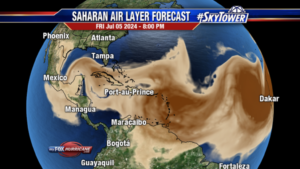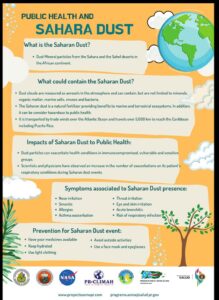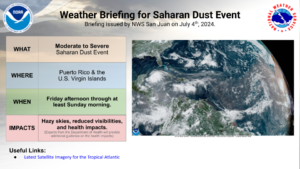
The National Weather Service has noted that dry air and a large plume of Saharan dust are forecast to arrive across Puerto Rico and the Virgin Islands on Friday and impact the islands this weekend.
“A plume of Saharan dust will begin to affect the local region, with direct impacts to Puerto Rico and the U.S. Virgin Islands,” according to an update from the NWS in San Juan, Puerto Rico. “This event is classified as moderate to severe and is expected to last until at least Sunday morning.”
The desert sand travels thousands of miles from Northern Africa via winds in the upper atmosphere and can affect weather conditions in the Caribbean. (Click here to view a forecast Saharan Air Layer map showing the large plume of sand arriving over the area on Friday.)
“Saharan dust is what it sounds like — dust and sand from the Sahara Desert, which is lofted up and transported over the Atlantic Ocean by the trade winds,” according to a previous Source interview with Jake Carstens, a postdoctoral scholar in the Department of Meteorology and Atmospheric Science at Pennsylvania State University. “These [dust] events can occur year-round, usually several times per year. Dust most often reaches the Caribbean and North/Central America in the spring and summer,” Carstens said.
Saharan Dust and Impacts on Health

“Perhaps the most obvious consequence of Saharan dust is its impact on visibility and air quality,” Carstens stated. “It can make breathing difficult, especially for people with existing lung conditions, and it’s recommended that people limit outdoor activity as much as possible on dusty days,” Carstens advised.
Another previous Source article outlines the potential health threats associated with the dust, according to information obtained from the Centers for Disease Control and Prevention (CDC).
“Saharan dust can be harmful to your health,” the CDC said. “The particles can be breathed in and enter your lungs and bloodstream, potentially triggering asthma attacks in people who have asthma and aggravating other respiratory conditions. Saharan dust worsens air quality and increases the levels of particulate matter [pollution] in the air,” the CDC continued.
The CDC recommends remaining indoors as much as possible when high concentrations of sand particles are in the air.
“Saharan dust can affect anyone,” the CDC cautioned. “But like all particulate pollution, it bothers some people more than others. People most likely to experience health problems caused by exposure to Saharan dust include children and babies, older adults, people with underlying lung conditions, and people with chronic cardiopulmonary diseases,” the CDC explained.
Tropical Wave to Arrive Next Week
A benefit of the prevalence of Saharan dirt is that it can help prevent the development of tropical cyclones. However, the dust is not expected to last, as a tropical wave is forecast to pass by the local islands early next week, bringing an increased potential of rainfall.
The latest wave comes on the heels of destructive Hurricane Beryl, which passed south of the V.I. earlier this week and left a trail of destruction across portions of the Caribbean. The cyclone still remains a major threat and as of Friday, Beryl is forecast to make landfall near southeast Texas early next week.

“On Monday, residual Saharan dust particles will remain in low concentrations across Puerto Rico and the U.S. Virgin Islands,” the NWS explained. “Nonetheless, by late Monday, expect an increase in moisture and shower activity as a tropical wave, along with a wind surge, reaches the islands on Tuesday,” the NWS added.
“This [tropical] wave will move relatively fast across the region, particularly on Tuesday,” the NWS noted. “With it, expect the passing showers to increase across the islands during the morning hours, with moderate to heavy showers and isolated thunderstorms expected across the western and northwestern portions of Puerto Rico during the afternoon hours.”
Weather Updates
While the presence of dust can potentially help thwart the development of tropical systems, it is vital to be prepared throughout the 2024 Atlantic Hurricane Season.
V.I. residents and visitors can find weather information and obtain alerts from the Virgin Islands Territorial Emergency Management Agency website and the National Weather Service. A daily weather post is also published on the Source Weather Page, and a daily weather forecast video is also available to view.





